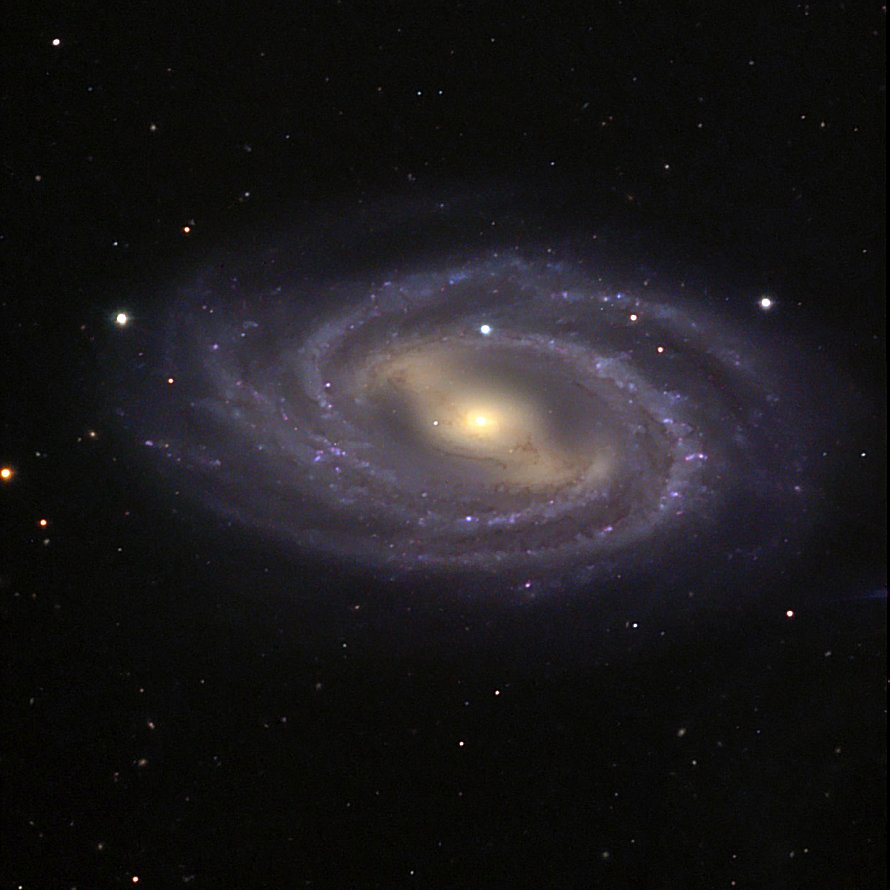M109 (NGC 3992)
Messier 109 (NGC 3992) is a barred spiral galaxy located in the constellation Ursa Major in the Ursa Major Group of galaxies. M109 is 83500000 light years away from Earth.
M109 is best viewed during early spring, is magnitude 10.6, and can be viewed with small telescope. M109 is 7.6' x 4.7' in apparent size. For reference, the full moon is 30'.
Observing difficulty: Hard
- Name:
- Type:
- barred spiral galaxy
- Constellation:
- Ursa Major
- NGC or IC:
- NGC 3992
- Magnitude:
- 10.6
- Viewing:
- small telescope
- Size:
- 7.6' x 4.7'
- Distance (light years):
- 83500000 LY
- RA:
- 11h 57.6m
- Dec:
- 53 23'
- Season:
- early spring
- Galaxy group:
- Ursa Major Group
- Messier Marathon #:
- 38
* The naked eye can see up to magnitude ~7-8 objects under ideal dark sky conditions.
A Barred Spiral Galaxy in Ursa Major
Messier 109, often referred to as M109 or NGC 3992, is a prominent barred spiral galaxy nestled within the constellation Ursa Major, also known as the Great Bear. This object was first sighted by Charles Messier's assistant Pierre M?chain in 1781 and later added to Messier's catalogue. However, the object wasn't officially recognized as part of the catalogue until the 20th century by astronomy historian and researcher Owen Gingerich.
Structural Characteristics of Messier 109
Belonging to the Ursa Major Cluster, Messier 109 is classified as an SBbc galaxy, representing a barred spiral with intermediate to loosely wound arms. The galaxy is remarkable for its well-defined bar structure and several spiral arms containing a multitude of star-forming regions, easily detected in radio wavelengths due to abundant interstellar gas and dust.
The disc of M109 is observed nearly face-on from our vantage point on Earth, offering a spectacular view of its structure. Studies indicate the presence of a low-ionization nuclear emission-line region (LINER) in its core, which is typically associated with weakly active galactic nuclei.
Apparent Magnitude and Distance
Messier 109 has an apparent magnitude of 10.6, meaning it isn't visible to the naked eye but can be seen using a modestly-sized amateur telescope under optimal conditions. It resides approximately 83.5 million light-years away from Earth, making it one of the more distant objects in the Messier catalogue.
Finding and Observing Messier 109
Despite its relative dimness, finding Messier 109 can be fairly straightforward due to its location near Phecda (Gamma Ursae Majoris), one of the stars forming the bowl of the Big Dipper asterism in Ursa Major. M109 is found just less than a degree southeast of this star.
A small telescope will reveal the galaxy as a faint patch of light, but a larger telescope is required to make out its barred spiral structure. Observers will find a challenge in discerning the galaxy's detailed features given its distance and the relatively small size of its angular diameter. To fully appreciate its intricate structure, astrophotography or viewing through large telescopes at a dark site would be advantageous.
In conclusion, Messier 109 is a fascinating deep-sky object of interest for both amateur stargazers and professional astronomers, offering a glimpse into the dynamic and intricate structure of barred spiral galaxies.



